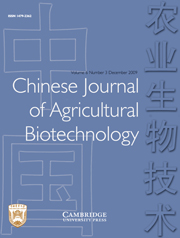No CrossRef data available.
Article contents
Cloning of a cDNA fragment of an antenna-specific gene in Helicoverpa armigera
Published online by Cambridge University Press: 12 February 2007
Abstract
The olfactory sensors of insects' antennae, which are directly exposed to the environment, play an important role in identifying volatile hydrophobic molecules in the air. As many odours in the air are cytotoxic xenobiotics, there must be mechanisms in insects' antennae to decompose the molecules and also redundant odorant stimulators. In the present study, differential display PCR was used to isolate three antenna-specific mRNAs from the moth of the cotton bollworm, Helicoverpa armigera. Sequence analysis of the A4-1 clone indicated that it was homologous to the glutathione-S-transferase (GST) protein family. Northern blotting showed that the A4-1 clone was expressed specifically in the antennae of H. armigera and the expressed level was higher in male antennae than in female ones; this is similar to the expression of PBP-Harm gene from cotton bollworm. According to the gene's expression in antennae and the role of GST reported in other insects, the gene is predicted to be responsible for the decomposition of pheromones and harmful xenobiotics in antennae.
Keywords
- Type
- Research Article
- Information
- Copyright
- Copyright © China Agricultural University and Cambridge University Press 2004


